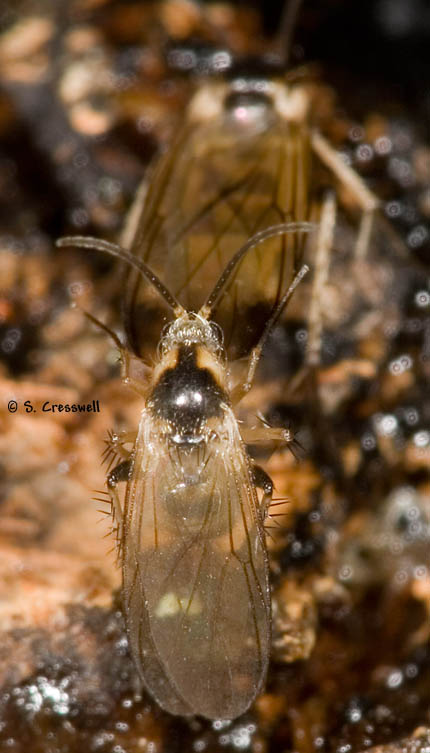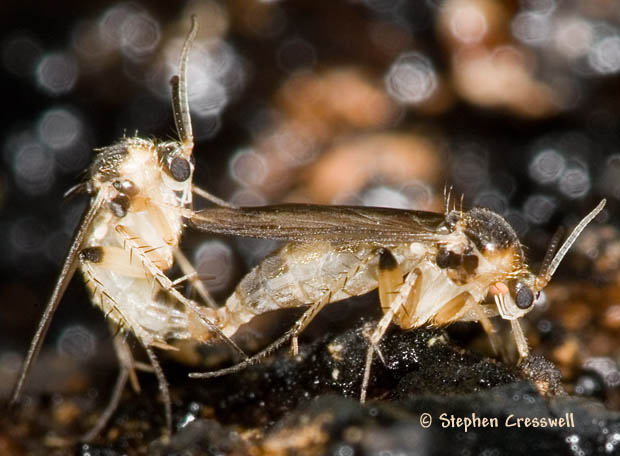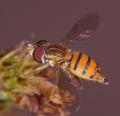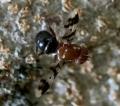Diptera.info :: Identification queries :: Diptera (adults)
Who is here? 1 guest(s)
|
Mating Flies, Spiny Legs
|
|
| Stephen |
Posted on 07-11-2006 15:20
|
|
Member Location: West Virginia USA Posts: 1322 Joined: 12.04.05 |
This pair of small flies were on a Sugar Maple tree that was oozing sap. With legs this spiny, they must be in Mycetophilidae? Length hard to measure in this posture, but about 4.5 mm from the front of the eyes to the rear of the abdomen. Date 6 November 2006, West Virginia USA, woodlands. Stephen attached the following image:  [83.64Kb] --Stephen Stephen Cresswell www.americaninsects.net |
| Stephen |
Posted on 07-11-2006 15:21
|
|
Member Location: West Virginia USA Posts: 1322 Joined: 12.04.05 |
The lateral view.
Stephen attached the following image:  [88.12Kb] --Stephen Stephen Cresswell www.americaninsects.net |
| Tony Irwin |
Posted on 07-11-2006 18:28
|
|
Member Location: Norwich, England Posts: 7280 Joined: 19.11.04 |
Certainly Mycetophilidae, and looks very like Mycetophila.
Tony ---------- Tony Irwin |
|
|
|
| Stephen |
Posted on 08-11-2006 00:05
|
|
Member Location: West Virginia USA Posts: 1322 Joined: 12.04.05 |
Tony, thanks again for your ID help. I had never seen a fungus gnat with patterning on the dorsal surface of the thorax and I loved that punk rock hair style that he has too. (Both traits best visible on the male in the top picture.)
--Stephen Stephen Cresswell www.americaninsects.net |
| Paul Beuk |
Posted on 08-11-2006 07:17
|
|
Super Administrator Location: Netherlands Posts: 19403 Joined: 11.05.04 |
Wing venation is off for Mycetophila. It is a species of the Leiini, possible Leia. I guess you did not collect the gnats?
Paul - - - - Paul Beuk on https://diptera.info |
| Stephen |
Posted on 08-11-2006 10:48
|
|
Member Location: West Virginia USA Posts: 1322 Joined: 12.04.05 |
No, didn't collect. I did take a very large number of pictures, so let me know if a particular feature needs more detail. One thing I have to sort out, though, is whether more than one species of Fungus Gnat was present at the Sugar Maple tree, and I think there was. About half my photos were of this mating pair, though, and I am certain there was only one mating pair. 
--Stephen Stephen Cresswell www.americaninsects.net |
| Stephen |
Posted on 08-11-2006 11:24
|
|
Member Location: West Virginia USA Posts: 1322 Joined: 12.04.05 |
Here is one of the "singles" of the Fungus Gnats, and judging by the markings on the thorax it is the same species as the mating pair. Looking at the wing, though, this one has a small square closed cell near the leading edge that the other photo (at the top of this page) doesn't show. My other photos have some of the Fungus Gnats with this cell and some without. What is going on? Stephen attached the following image:  [116.48Kb] --Stephen Stephen Cresswell www.americaninsects.net |
| Paul Beuk |
Posted on 08-11-2006 13:19
|
|
Super Administrator Location: Netherlands Posts: 19403 Joined: 11.05.04 |
The first two pics appear to be of the same species (the first taken slightly before copulation took place). The second is a species of Monoclona (not the close cell in the wing that is absent in the first picture).
Paul - - - - Paul Beuk on https://diptera.info |
| Tony Irwin |
Posted on 09-11-2006 00:06
|
|
Member Location: Norwich, England Posts: 7280 Joined: 19.11.04 |
I must finish producing that "foolish" smiley - I really need it so often!  Thanks to Paul's correction, I've looked a bit more closely at the first image and the wing venation and colour in particular. It does seem that vein m has a broken fork, the anterior branch being detached, and the wing tip is heavily clouded - suggesting Rondaniella dimidiata. The image from Cedar Creek (http://www.cedarc...080ap.html) looks like a good match Edited by Tony Irwin on 09-11-2006 00:07 Tony ---------- Tony Irwin |
|
|
|
| Stephen |
Posted on 09-11-2006 01:16
|
|
Member Location: West Virginia USA Posts: 1322 Joined: 12.04.05 |
Tony and Paul, thanks so much for your help with these. Let me just add for the record, that I am quite certain the first and second photos on this page show the same pair of flies. I took quite a few consecutive photos of them over the course of several minutes, and these two photos are from that series. By the way, nearctica.com lists only one species in Rondaniella for America north of Mexico, namely R. sororcula Loew 1869 (Leia). Is my pair likely this species, or is there a nomenclature issue in this genus? Edited by Stephen on 09-11-2006 01:21 --Stephen Stephen Cresswell www.americaninsects.net |
| Paul Beuk |
Posted on 09-11-2006 08:29
|
|
Super Administrator Location: Netherlands Posts: 19403 Joined: 11.05.04 |
I thought about Rondaniella dimidiata (the name for the single NA species mentioned in the Manual of Neactic Diptera) but could not be quite certain that M1 was indeed detached from the main M vein...
Paul - - - - Paul Beuk on https://diptera.info |
| Stephen |
Posted on 09-11-2006 11:47
|
|
Member Location: West Virginia USA Posts: 1322 Joined: 12.04.05 |
Since Nomina Insecta Nearctica listed one species of Rondaniella for the Nearctic (R. sororcula), and since the Manual of Neactic Diptera listed one (R. dimidata), I wondered if maybe these two names were synonyms. After thirty minutes of web surfing on these names I am confused. The "World Diptera Nomenclator" website says there are two Mycetophilids with valid species names sororcula: Exechia sororcula and Mycomya sororcula. They have no record of the name R. sororcula ever being used. Harvard's website has beautiful photos of Leia sororcula, a name that the World Diptera Nomenclator website said was a junior synonym of Exechia sororcula. Cedar Creek as you note, Tony, has nice photos from Minnesota USA of R. dimidata, even though Nomina Insecta Nearctica does not list that species, nor any Mycetophilid with the species name dimidata. It sounds like R. dimidata is the name to go with, and for the moment the listing of Nomina Insecta Nearctica for R. sororcula is unexplained. 
--Stephen Stephen Cresswell www.americaninsects.net |
| Tony Irwin |
Posted on 09-11-2006 20:55
|
|
Member Location: Norwich, England Posts: 7280 Joined: 19.11.04 |
Fauna Europaea (perhaps no more reliable than Nomina Insecta Nearctica?) gives sororcula (Loew 1869) (- originally in Leia) as a synonym of Rondaniella dimidiata (Meigen 1804). Leia abbreviata, apicalis, elegans, terminalis and variegata are all listed as synonyms as well. As Peter Chandler is listed as the taxonomic specialist for this page, I'm inclined to accept what it says, so Rondaniella dimidiata looks like the current name.
Tony ---------- Tony Irwin |
|
|
|
| Paul Beuk |
Posted on 09-11-2006 21:24
|
|
Super Administrator Location: Netherlands Posts: 19403 Joined: 11.05.04 |
Dunno who did the synonymization, but the sororcula name came from the North American catalogue (Stone et al.) and was repeated in the Nomina.
Paul - - - - Paul Beuk on https://diptera.info |
| Jump to Forum: |













